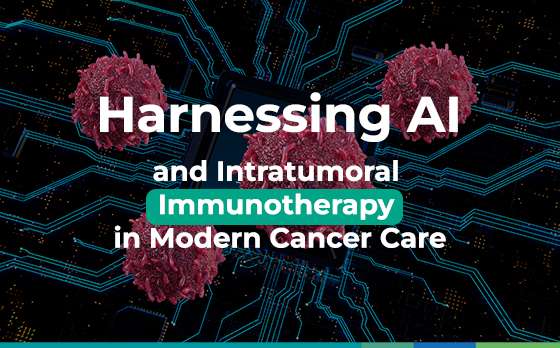The development of immunotherapy (IO) has revolutionized cancer treatment by enabling the immune system to target and eliminate cancer cells more effectively. However, evaluating the success of these therapies remains challenging due to unique response patterns, such as pseudoprogression and hyperprogression, which traditional methods based on tumor size fail to capture. Intratumoral immunotherapy (IT-IO) stands out as a powerful approach that directly targets the tumor microenvironment, enhancing immune responses while minimizing adverse effects. A review carried out by Sajan et al. (2024) explores how advances in artificial intelligence (AI) are helping improve the assessment and precision of IT-IO, presenting new avenues for personalized cancer care.
Intratumoral Immunotherapy (IT-IO): Localized and Effective
Unlike systemic immunotherapy, which can circulate throughout the body, IT-IO involves the direct injection of immune-stimulating agents into tumors. This method has several benefits: it can convert immunologically “cold” tumors, which typically evade the immune system, into “hot” tumors that are more susceptible to immune attack. By delivering treatment locally, IT-IO requires lower doses, reduces the risk of systemic side effects, and allows for combination with other treatments without heightened toxicity. However, IT-IO faces challenges such as the variability of tumor antigens and the need for more extensive, long-term data compared to systemic therapies.
AI and Radiomics: Enhancing the Precision of IO
Integrating AI and radiomics into IO offers powerful capabilities by analyzing complex imaging data, identifying biomarkers, and predicting responses to treatment. AI-driven models can analyze subtle changes in tumor characteristics that may not be visible with traditional imaging techniques. For instance, AI can interpret variations in tumor tissue composition, monitor changes in tumor microenvironments, and detect biomarkers that inform about the immune status of tumors. While promising, the use of AI in oncology faces challenges, including the need for large datasets and standardized methods to ensure reproducibility across studies. The field is rapidly evolving, and significant work remains to integrate AI fully into clinical workflows.
AI in Action: Imaging Biomarkers and Treatment Response Prediction
Studies such as the KEYNOTE-002 and KEYNOTE-006 trials have demonstrated AI’s ability to analyze CT images, predicting survival in melanoma patients treated with systemic IO with greater accuracy than traditional metrics. Although these findings are promising, the application of AI to predict outcomes in patients undergoing IT-IO is still developing. Future studies aim to optimize these AI models to capture the unique dynamics of tumors treated with IT-IO, ultimately enhancing precision in treatment assessment and adaptation.
Image-Guided Interventions in the Age of Precision Medicine
AI can significantly enhance IT-IO by optimizing image-guided interventions, such as targeting specific regions within a tumor based on its biological characteristics. AI-driven radiomics extracts detailed information from standard imaging methods (e.g., CT scans) that might otherwise go unnoticed. For example, AI can guide intratumoral injections to areas that will yield the best immune response, transforming cold tumors into hot ones, increasing therapeutic efficacy, and reducing potential toxicity. While AI in this field is still in developmental stages, continued research aims to validate its benefits in clinical settings, paving the way for more personalized, effective, and less invasive treatments.

Figure 1. Uses of AI in modern intratumoral immunotherapy (Image made with BioRender).
Toward a New Standard in Personalized Cancer Care
The rapid advancement of cancer care, fueled by innovations in IO and AI, is transforming traditional oncology practices. AI and machine learning hold the potential to refine diagnostics, predict treatment outcomes, and individualize therapeutic strategies for various cancer types. As AI-driven techniques become more sophisticated and integrated into clinical practice, they promise to optimize IO efficacy, reduce side effects, and potentially improve survival rates and quality of life for cancer patients. This evolution marks a critical step toward truly personalized cancer care, setting a new standard in precision medicine and offering renewed hope for patients.
Main Reference:
Sajan, A., Lamane, A., Baig, A., Floch, K. L., & Dercle, L. (2024). The emerging role of AI in enhancing intratumoral immunotherapy care. Oncotarget, 15, 635–637. https://doi.org/10.18632/oncotarget.28643
Other references:
Dercle, L., Sun, S., Seban, R. D., Mekki, A., Sun, R., Tselikas, L., Hans, S., Bernard-Tessier, A., Mihoubi Bouvier, F., Aide, N., Vercellino, L., Rivas, A., Girard, A., Mokrane, F. Z., Manson, G., Houot, R., Lopci, E., Yeh, R., Ammari, S., & Schwartz, L. H. (2023). Emerging and Evolving Concepts in Cancer Immunotherapy Imaging. Radiology, 306(1), 32–46. https://doi.org/10.1148/radiol.210518
Marabelle, A., Tselikas, L., de Baere, T., & Houot, R. (2017). Intratumoral immunotherapy: using the tumor as the remedy. Annals of oncology : official journal of the European Society for Medical Oncology, 28(suppl_12), xii33–xii43. https://doi.org/10.1093/annonc/mdx683
Dercle, L., McGale, J., Sun, S., Marabelle, A., Yeh, R., Deutsch, E., Mokrane, F. Z., Farwell, M., Ammari, S., Schoder, H., Zhao, B., & Schwartz, L. H. (2022). Artificial intelligence and radiomics: fundamentals, applications, and challenges in immunotherapy. Journal for immunotherapy of cancer, 10(9), e005292. https://doi.org/10.1136/jitc-2022-005292


